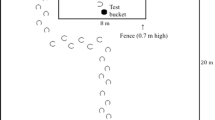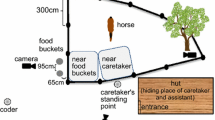Abstract
A previous study demonstrated that horses can learn socially from observing humans, but could not draw any conclusions about the social learning mechanisms. Here we develop this by showing horses four different human action sequences as demonstrations of how to press a button to open a feed box. We tested 68 horses aged between 3 and 12 years. 63 horses passed the habituation phase and were assigned either to the group Hand Demo (N = 13) for which a kneeling person used a hand to press the button, Head Demo (N = 13) for which a kneeling person used the head, Mixed Demo (N = 12) for which a squatting person used both head and hand, Foot Demo (N = 12) in which a standing person used a foot, or No Demo (N = 13) in which horses did not receive a demonstration. 44 horses reached the learning criterion of opening the feeder twenty times consecutively, 40 of these were 75% of the Demo group horses and four horses were 31% of the No Demo group horses. Horses not reaching the learning criterion approached the human experimenters more often than those who did. Significantly more horses used their head to press the button no matter which demonstration they received. However, in the Foot Demo group four horses consistently preferred to use a hoof and two switched between hoof and head use. After the Mixed Demo the horses’ actions were more diverse. The results indicate that only a few horses copy behaviours when learning socially from humans. A few may learn through observational conditioning, as some appeared to adapt to demonstrated actions in the course of reaching the learning criterion. Most horses learn socially through enhancement, using humans to learn where, and which aspect of a mechanism has to be manipulated, and by applying individual trial and error learning to reach their goal.


Similar content being viewed by others
References
Blackmore TL, Foster TM, Sumpter CE, Temple W (2008) An investigation of colour discrimination with horses (Equus caballus). Behav Process 78:387–396. https://doi.org/10.1016/j.beproc.2008.02.003
Brubaker L, Udell MAR (2016) Cognition and learning in horses (Equus caballus): what we know and why we should ask more. Behav Process 126:121–131. https://doi.org/10.1016/j.beproc.2016.03.017
Byrne RW (1994) The evolution of intelligence. In: Slater PJB, Halliday TR (eds) Behaviour and evolution. Cambridge University Press, Cambridge, pp 223–265
Byrne RW (2002) Imitation of novel complex actions: what does the evidence from animals mean? In: Snowdon CT, Roper TJ (eds) Advances in the study of behavior. Academic Press, San Diego, pp 77–105
Byrne RW (2009) Animal imitation. Curr Biol 19:R111–R114. https://doi.org/10.1016/j.cub.2008.11.027
Byrne R, Whiten A (1988) Machiavellian intelligence. Oxford Univ Press, Oxford
Carroll J, Murphy CJ, Neitz M, Hoeve JN, Neitz J (2001) Photopigment basis for dichromatic color vision in the horse. J Vis 1:80–87. https://doi.org/10.1167/1.2.2
Cook M, Mineka S, Wolkenstein B, Laitsch K (1985) Observational conditioning of snake fear in unrelated rhesus monkeys. J Abnorm Psychol 94:591–610
Custance D, Whiten A, Fredman T (1999) Social learning of an artificial fruit task in capuchin monkeys (Cebus apella). J Comp Psychol 113:13–23. https://doi.org/10.1037/0735-7036.113.1.13
Deutsche Reiterliche Vereinigung e.V (2014) Pferde verstehen—Umgang und Bodenarbeit. FN Verlag der deutschen Reiterlichen Vereinigung GmbH, Warendorforey
d’Ingeo S, Quaranta A, Siniscalchi M, Stomp M, Coste C, Bagnard C et al (2019) Horses associate individual human voices with the valence of past interactions: a behavioural and electrophysiological study. Sci Rep 9:11568. https://doi.org/10.1038/s41598-019-47960-5
Dorey NR, Conover AM, Udell MAR (2014) Interspecific communication from people to horses (Equus ferus caballus) is influenced by different horsemanship training styles. J Comp Psychol 128(4):337–342. https://doi.org/10.1037/a0037255
Feh C, de Mazières J (1993) Grooming at a preferred site reduces heart rate in horses. Anim Behav 46:1191–1194. https://doi.org/10.1006/anbe.1993.1309
Flannery B (1997) Relational discrimination learning in horses. Appl Anim Behav Sci 54:267–280. https://doi.org/10.1016/S0168-1591(97)00006-3
Galef BG (1989) Enduring social enhancement of rats’ preferences for the palatable and the piquant. Appetite 13:81–92. https://doi.org/10.1016/0195-6663(89)90106-2
Greco BJ, Brown TK, Andrews JRM, Swaisgood RR, Caine NG (2013) Social learning in captive African elephants (Loxodonta africana africana). Anim Cogn 16:459–469. https://doi.org/10.1007/s10071-012-0586-7
Hall CA, Cassaday HJ, Derrington AM (2003) The effect of stimulus height on visual discrimination in horses. J Anim Sci 81(7):1715–1720
Healy SD, Jones CM (2002) Animal learning and memory: an integration of cognition and ecology. Zoology 105:321–327. https://doi.org/10.1078/0944-2006-00071
Heyes CM (1994) Social learning in animals: categories and mechanisms. Biol Rev 69:207–231. https://doi.org/10.1111/j.1469-185X.1994.tb01506.x
Hopewell L, Leaver L, Lea S, Wills A (2010) Grey squirrels (Sciurus carolinensis) show a feature-negative effect specific to social learning. Anim Cogn 13:219–227. https://doi.org/10.1007/s10071-009-0259-3
Hoppitt W, Laland KN (2008) Social processes influencing learning in animals: a review of the evidence. Adv Study Behav 38:105–165. https://doi.org/10.1016/S0065-3454(08)00003-X
Irving-Pease EK, Ryan H, Jamieson A, Dimopoulos EA, Larson G, Frantz LAF (2019) Paleogenomics of animal domestication. In: Lindqvist C, Rajora OP (eds) Paleogenomics: genome-scale analysis of ancient DNA. Springer International Publishing, Cham, pp 225–272
Krueger K, Heinze J (2008) Horse sense: social status of horses (Equus caballus) affects their likelihood of copying other horses` behavior. Anim Cogn 11:431–439. https://doi.org/10.1007/s10071-007-0133-0
Krueger K, Flauger B, Farmer K, Maros K (2011) Horses (Equus caballus) use human local enhancement cues and adjust to human attention. Anim Cogn 14:187–201. https://doi.org/10.1007/s10071-010-0352-7
Krueger K, Farmer K, Heinze J (2014) The effects of age, rank and neophobia on social learning in horses. Anim Cogn 17:645–655. https://doi.org/10.1007/s10071-013-0696-x
Kubinyi E, Topál J, Miklósi Á, Csányi V (2003) Dogs (Canis familiaris) learn their owners via observation in a manipulation task. J Comp Psychol 117:156–165. https://doi.org/10.1037/0735-7036.117.2.156
Lamp JF, Andre J (2012) Cross-modal recognition of human individuals in domestic horses (Equus caballus). Anim Cogn 15:623–630. https://doi.org/10.1007/s10071-012-0490-1
Leadbeater E, Dawson EH (2017) A social insect perspective on the evolution of social learning mechanisms. Proc Natl Acad Sci USA 114:7838–7845
Lesimple C, Sankey C, Richard M-A, Hausberger M (2012) Do horses expect humans to solve their problems? Front Psychol 3:306. https://doi.org/10.3389/fpsyg.2012.00306
Lovrovich P, Sighieri C, Baragli P (2015) Following human-given cues or not? Horses (Equus caballus) get smarter and change strategy in a delayed three choice task. Appl Anim Behav Sci 166:80–88. https://doi.org/10.1016/j.applanim.2015.02.017
Malavasi R, Huber L (2016) Evidence of heterospecific referential communication from domestic horses (Equus caballus) to humans. Anim Cogn 19:899–909. https://doi.org/10.1007/s10071-016-0987-0
Maros K, Gácsi M, Miklósi Á (2008) Comprehension of human pointing gestures in horses (Equus caballus). Anim Cogn 11:457–466. https://doi.org/10.1007/s10071-008-0136-5
McDonnell SM, Haviland JCS (1995) Agonistic ethogram of the equid bachelor band. Appl Anim Behav Sci 43:147–188. https://doi.org/10.1016/0168-1591(94)00550-X
Mejdell CM, Buvik T, Jørgensen GHM, Bøe KE (2016) Horses can learn to use symbols to communicate their preferences. Appl Anim Behav Sci 184:66–73. https://doi.org/10.1016/j.applanim.2016.07.014
Mersmann D, Tomasello M, Call J, Kaminski J, Taborsky M (2011) Simple mechanisms can explain social learning in domestic dogs (Canis familiaris). Ethology 117:675–690. https://doi.org/10.1111/j.1439-0310.2011.01919.x
Miklósi Á, Soproni K (2006) A comparative analysis of animals’ understanding of the human pointing gesture. Anim Cogn 9:81–93. https://doi.org/10.1007/s10071-005-0008-1
Mills DS, McDonnell SM (2005) The domestic horse. Cambridge University Press, Camebridge
Nicol CJ (2002) Equine learning: progress and suggestions for future research. Appl Anim Behav Sci 78:193–208. https://doi.org/10.1016/S0168-1591(02)00093-X
Pfungst O (1907) Der Kluge Hans. Ein Beitrag zur nichtverbalen Kommunikation. Frankfurter Fachbuchhandlung für Psychologie, Frankfurt am Main
Pongrácz P, Miklósi Á, Kubinyi E, Gurobi K, Topál J, Csányi V (2001) Social learning in dogs: the effect of a human demonstrator on the performance of dogs in a detour task. Anim Behav 62:1109–1117. https://doi.org/10.1006/anbe.2001.1866
Pongrácz P, Miklósi Á, Timár-Geng K, Csányi V (2004) Verbal attention getting as a key factor in social learning between dog and human. J Comp Psychol 118:375–383
Pongrácz P, Miklósi Á, Vida V, Csányi V (2005) The pet dogs ability for learning from a human demonstrator in a detour task is independent from the breed and age. Appl Anim Behav Sci 90:309–323. https://doi.org/10.1016/j.applanim.2004.08.004
Proops L, McComb K (2010) Attributing attention: the use of human-given cues by domestic horses (Equus caballus). Anim Cogn 13:197–205. https://doi.org/10.1007/s10071-009-0257-5
Proops L, McComb K (2012) Cross-modal individual recognition in domestic horses (Equus caballus) extends to familiar humans. Proc R Soc B 279:3131–3138. https://doi.org/10.1098/rspb.2012.0626
Proops L, McComb K, Reby D (2009) Cross-modal individual recognition in domestic horses (Equus caballus). Proc Natl Acad Sci USA 106:947–951. https://doi.org/10.1073/pnas.0809127105
Proops L, Walton M, McComb K (2010) The use of human-given cues by domestic horses, Equus caballus, during an object choice task. Anim Behav 79:1205–1209. https://doi.org/10.1016/j.anbehav.2010.02.015
Proops L, Rayner J, Taylor AM, McComb K (2013) The responses of young domestic horses to human-given cues. PLoS One. https://doi.org/10.1371/journal.pone.0067000
R Development Core Team (2019) R: a language and environment for statistical computing. http://www.R-project.org
Rescorla RA, Holland PC (1982) Behavioral Studies of Associative Learning in Animals. Ann Rev Psychol 33:265–308
Ringhofer M, Yamamoto S (2017) Domestic horses send signals to humans when they face with an unsolvable task. Anim Cogn 20:397–405. https://doi.org/10.1007/s10071-016-1056-4
Rørvang MV, Ahrendt LP, Christensen JW (2015) A trained demonstrator has a calming effect on naïve horses when crossing a novel surface. Appl Anim Behav Sci 171:117–120. https://doi.org/10.1016/j.applanim.2015.08.008
Sankey C, Henry S, André N, Richard-Yris M-A, Hausberger M (2011) Do horses have a concept of person? PLoS One. https://doi.org/10.1371/journal.pone.0018331
Schuetz A, Farmer K, Krueger K (2017) Social learning across species: horses (Equus caballus) learn from humans by observation. Anim Cogn 20:567–573. https://doi.org/10.1007/s10071-016-1060-8
Shettleworth SJ (1998) Cognition, evolution and behaviour. Oxford University Press, Oxford
Smith AV, Proops L, Grounds K, Wathan J, McComb K (2016) Functionally relevant responses to human facial expressions of emotion in the domestic horse (Equus caballus). Biol Lett. https://doi.org/10.1098/rsbl.2015.0907
Thorpe WH (1963) Learning and instinct in animals. Methuen, London
Tomasello M (1990) Cultural transmission in the tool use and communicatory signalling of chimpanzees? In: Parker ST, Gibson KR (eds) Language and intelligence in monkeys and apes. Cambridge University Press, Cambridge, pp 274–311
Topál J, Miklósi A, Csányi V (1997) Dog-human relationship affects problem solving be-havior in the dog. Anthrozoos 10:214–224
Whalen A, Cownden D, Laland K (2015) The learning of action sequences through social transmission. Anim Cogn 18:1093–1103. https://doi.org/10.1007/s10071-015-0877-x
Whiten A, Ham R (1992) On the nature and evolution of imitation in the animal kingdom: reappraisal of a century of research. Adv Study Behav 21:239–283
Whiten A, Horner V, Litchfield CA, Marshall-Pescini S (2004) How do apes ape? Learn Behav 32:36–52. https://doi.org/10.3758/BF03196005
Zajonc RB (1965) Social facilitation. Science 149:269–274. https://doi.org/10.1126/science.149.3681.269
Zentall TR (2006) Imitation: definitions, evidence, and mechanisms. Anim Cogn 9:335–353. https://doi.org/10.1007/s10071-006-0039-2
Acknowledgements
We thank Richard Byrne, Ádam Miklósi and many others for discussing the data, many persons for assisting in the experiments, several horse owners for supplying the experiment with their horses and three anonymous referees and the editor for helping to improve the manuscript.
Funding
This study was not funded.
Author information
Authors and Affiliations
Corresponding author
Ethics declarations
Ethical approval
All applicable international, national, and/or institutional guidelines for the care and use of animals were followed and approved by the animal welfare board of Nürtingen-Geislingen University. All procedures performed in the study involving human participants were in accordance with the ethical standards of the ethics committee of Nürtingen-Geislingen University and with the 1964 Helsinki declaration and its later amendments or comparable ethical standards.
Informed consent
Informed consent was obtained from all individual participants included in the study.
Additional information
Publisher's Note
Springer Nature remains neutral with regard to jurisdictional claims in published maps and institutional affiliations.
Electronic supplementary material
Below is the link to the electronic supplementary material.
10071_2019_1310_MOESM1_ESM.pdf
Source information for images all the images of the present manuscript (Fig. 1 and Fig. 2, main manuscript, and Fig. ESM 2, Fig ESM 3, Table ESM 1, Table ESM 4 and Table 5, supplementary material) were created from pictures, graphs and tables made by the authors of the present study themselves (PDF 999 kb)
Rights and permissions
About this article
Cite this article
Bernauer, K., Kollross, H., Schuetz, A. et al. How do horses (Equus caballus) learn from observing human action?. Anim Cogn 23, 1–9 (2020). https://doi.org/10.1007/s10071-019-01310-0
Received:
Revised:
Accepted:
Published:
Issue Date:
DOI: https://doi.org/10.1007/s10071-019-01310-0




